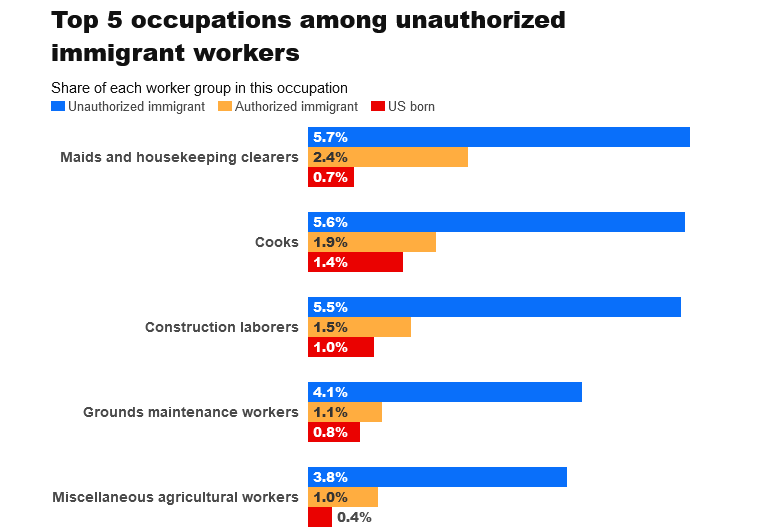Arizona is the epicenter of the debate over how Trump’s mass deportation plan would hit the economy

Mass deportations could disrupt the economy and reshape labor markets, many economists believe.
The mass deportation of people living in the US illegally has been one of the cornerstones of the Republican presidential ticket leading up to the November election.
In speeches, former president Donald Trump has suggested that deportations could lower housing prices and give legal residents, especially Black and Hispanic Americans, more job opportunities. His supporters say allowing migrants to enter the country and live and work illegally places a long-term burden on the economy.
“We’re going to have the largest deportation in the history of our country,” Trump said in September while taking reporter questions in Los Angeles. “And we’re going to start with Springfield and Aurora,” he added, referring to the Ohio and Colorado cities where debates around immigration have been particularly tense.
Many Democrats say mass deportations would hurt businesses and employment opportunities for all Americans, in addition to separating families and displacing millions of people. It’s especially salient in the crucial southern border swing state of Arizona.
“We all remember what they did to tear families apart, and now they have pledged to carry out the largest deportation — a mass deportation — in American history,” Vice President Kamala Harris said at a September conference. “Imagine what that would look like and what that would be. How is that going to happen? Massive raids? Massive detention camps?”
Current immigration policy already supports deporting large numbers of unauthorized residents. The Biden administration has deported over 1.1 million people from 2021 to February 2024, and Vice President Kamala Harris has supported higher standards for asylum eligibility.
Deportations would likely continue under Harris’ administration, but Trump’s proposals would be an order of magnitude greater and perhaps the most consequential outcome of his second term.
A September Pew Research Center poll found that immigration is a key issue for more than half of Americans as they cast their ballots. To untangle the data and campaign rhetoric and understand the effects of mass deportation on the economy, B-17 reviewed research and spoke with over a dozen experts, politicians, local advocacy organizations, and immigrants.
2 cities in Arizona show the crux of the economic debate
Immigrants, both authorized and unauthorized, make up nearly 13% of Arizona’s population, one of the highest in the country, the nonpartisan think tank Migration Policy Institute estimates. Pew Research Center estimates as many as 250,000 Arizona residents could be deported under Trump’s plan.
Some of those deportees could be from Yuma, Arizona, a city near the US-Mexico border. Its mayor, Douglas Nicholls, told B-17 that upticks in illegal immigration have strained the city’s resources and infrastructure.
Nicholls, a Republican, plans to vote for Trump and wants the next president to focus on more funding and staffing for the Immigration and Customs Enforcement agency. He said the US needs to prioritize immediate processing for those seeking asylum, improve technology along the border, and expedite removal processes.
“We’re not equipped as a community to handle large amounts of people coming through without resources,” Nicholls said. “We don’t have a homeless shelter focused on migrants. Our homeless shelter is focused on pretty much residents, and it’s pretty busy at that already.”
When it comes to mass deportations, he said the town’s main industry, agriculture, wouldn’t suffer too much because employers use legal paths to work authorization, like H-2A or green-card programs, to recruit labor. He said that migrants tend to pass through Yuma before moving on.
Tucson’s mayor, Regina Romero, said the story is different in Arizona’s second-most populous city. She told B-17 that a mass deportation would devastate the agriculture, construction, and hospitality industries.
Romero, a Democrat who endorsed Vice President Kamala Harris, said immigrants living in the country illegally “pay taxes and have billions of dollars worth of spending power.”
Instead of deportation, Romero said she wants the federal government to add more judges and staff to shorten asylum-application wait times and invest more in infrastructure at ports of entry.
“For many decades, Tucson has known how to help immigrant refugee and asylum-seeking populations connect to whomever they need to connect to,” Romero said. “We know how to do it.”
The national economic impact of mass deportations
Removing the estimated 11.7 million unauthorized immigrants from the US would reshape the labor market, cost an enormous amount, strain government services, and affect economic growth and inflation for a decade or more.
Employment and the labor market
The Trump campaign and its allies have argued that deportations could open more employment opportunities for Americans.
Immigrants are “going to be attacking — and they already are — Black population jobs, the Hispanic population jobs, and they’re attacking union jobs, too,” Trump said at an October rally in Reading, Pennsylvania.
Immigrants account for a third of workers in jobs paying under $30,000 a year, the conservative think tank American Compass said. Duncan Braid, its coalition director, told B-17 that competition from those immigrants hurts lower-income Americans. He said while mass deportations may cost the government a lot of money, its role is to protect the Constitution and its citizens.
“We currently have a situation where there is sort of an unlimited number of lower-skilled people coming into this country, and them competing directly with other low-skilled Americans already here would necessarily, just based on very basic theory, suppress their wages,” Braid said.
Recent research suggests the opposite. A working paper by economists at the University of California, Davis, found that increases in immigration can boost native employment.
“We really don’t see much evidence of substitution between unauthorized immigrants and US-born people at all,” Chloe East, a fellow at the Brookings Institution, said. “That’s partly because the jobs that unauthorized immigrants are willing to take are lower-paying, are more dangerous, and are less desirable for other reasons.”

How much a mass deportation would cost the government
The Trump campaign has talked little about how mass deportations could be implemented and on what scale. While in the White House, Trump carried out about 1.5 million deportations and made similar promises about mass deportation but was met with various legal challenges. At a campaign rally on October 11 in Aurora, Colorado, Trump pledged to use a 1798 law to deport suspected members of cartels and gangs.
To carry out what he called “the largest domestic deportation operation in American history,” Trump plans to bolster ICE raids by reassigning federal agents and recruiting from local police forces and says he’ll order the construction of new detention camps for people waiting for their cases to be processed, The New York Times reported.
That would be an expensive undertaking. Using Census Bureau data, the American Immigration Council estimated it would cost the federal government over $315 billion, including hiring up to 409,000 new government employees.

In addition to labor market disruptions, economists also say the country would lose tax revenue. Unauthorized immigrants paid $96.7 billion in federal, state, and local taxes — about $8,889 per person — in 2022, the Institute on Taxation and Economic Policy said. In 2022, unauthorized immigrants paid about $704 million in state and local taxes in Arizona alone.
Supporters of deportation argue that the loss of tax revenue would be offset by savings on reduced services for immigrants. A study from the conservative Manhattan Institute estimated that while older and less-educated immigrants, on average, receive more in federal benefits than they pay in taxes, higher-educated young immigrants are taxed more than they get back over their lifetime.
The Trump campaign has made a similar argument, saying that welfare programs, taxpayer-subsidized health insurance, transportation costs through FEMA, and education expenses for immigrants ultimately cost taxpayers billions of dollars.
“The real economic crisis is the $182 billion American tax dollars spent each year to cover the costs of 20 million illegal immigrants that have flooded our communities thanks to Kamala Harris’ wide-open border policies,” Taylor Rogers, an RNC spokesperson, said in a statement to B-17.
“President Trump’s mass deportation of illegal immigrants will not only make our communities safer but will save Americans from footing the bill for years to come,” Rogers added.
Economic growth and inflation
Mass deportations could have consequences for economic growth as a whole. The Trump campaign hasn’t addressed overall growth and inflation concerns but has said deportations would help reduce demand in the housing market.
On a more macro scale, the Peterson Institute for International Economics said gross domestic product could fall 1.2% below baseline by 2028 if 1.3 million people are deported, while inflation could climb 0.5 percentage points above current estimates by 2026. In a more extreme scenario where 8.4 million people are deported, GDP could fall by 7.4% and inflation could climb 3.5 percentage points above baseline by the end of the decade.
The American Immigration Council has a similarly negative view of the economic impact. It estimated that the US could lose between 4.2% and 6.8% in GDP if about 11 million people are deported.
“It would be very easy for an average American to see the impact of this policy in their daily life,” Marcus Noland, the executive vice president and director of studies at the Peterson Institute, said.






